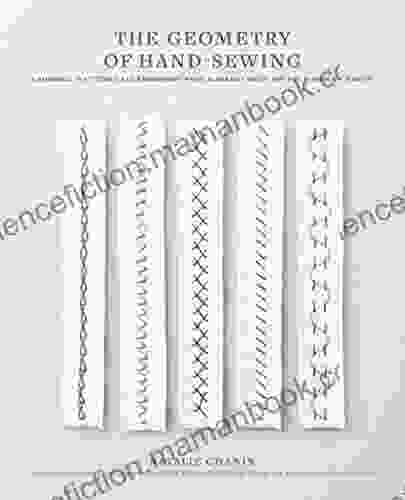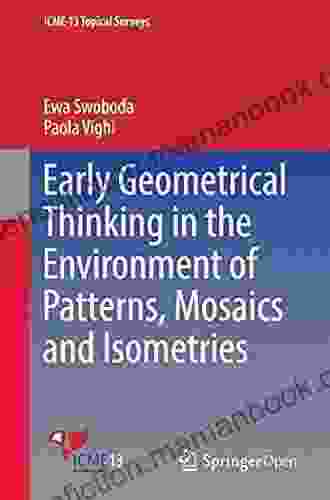Early Geometrical Thinking In The Environment Of Patterns Mosaics And: Understanding The Genesis of Spatial Reasoning

Geometry, the study of shapes, sizes, and spatial relationships, forms the bedrock of our understanding of the physical world. Geometric concepts are essential for navigating our surroundings, comprehending architectural designs, and appreciating artistic masterpieces. However, the genesis of geometrical thinking remains an enigma, with researchers seeking to unravel the cognitive processes that underpin our ability to perceive and reason about spatial configurations.
This article delves into the captivating world of early geometrical thinking, exploring the pivotal role of patterns and mosaics in fostering children's spatial reasoning abilities. We will journey through the history of geometrical education, uncovering the profound influence of ancient cultures on the development of geometric principles. Furthermore, we will examine contemporary research into the cognitive mechanisms underlying geometrical thinking, shedding light on the intricate interplay between perception, action, and cognition.
The origins of geometry can be traced back to the dawn of human civilization. Ancient cultures, from the Egyptians and Babylonians to the Greeks and Romans, developed sophisticated geometric systems to solve practical problems and advance their understanding of the cosmos.
4.1 out of 5
| Language | : | English |
| File size | : | 9023 KB |
| Print length | : | 192 pages |
One of the earliest manifestations of geometrical thinking can be found in the intricate patterns and mosaics that adorned the temples and palaces of ancient civilizations. These decorative elements, often composed of geometric shapes such as squares, triangles, and circles, showcased the artisans' remarkable ability to perceive and manipulate spatial relationships.
For instance, the Egyptians employed geometric principles in constructing their iconic pyramids, ensuring structural stability and precise alignment with the cardinal directions. The Babylonians, known for their advanced astronomy, developed a sophisticated system of geometry that enabled them to accurately predict celestial events.
Early childhood experiences with patterns and mosaics play a crucial role in the development of spatial reasoning abilities. Patterns, with their regular and repeating arrangements, provide children with a structured environment to explore spatial relationships and identify underlying geometric principles.
Mosaics, composed of small tiles arranged in intricate designs, challenge children to perceive and manipulate shapes and sizes, fostering their understanding of symmetry, congruence, and tessellation. By engaging with these visual patterns, children develop a repertoire of geometric concepts that lay the foundation for more complex geometrical reasoning.
Research studies have consistently demonstrated the positive impact of pattern and mosaic activities on children's spatial reasoning. For example, a study by Sarama and colleagues (2006) found that kindergarten children who participated in a pattern-based intervention exhibited significant improvements in their ability to recognize, create, and extend geometric patterns.
Contemporary research in cognitive psychology has shed light on the complex cognitive processes that underpin geometrical thinking. Researchers have identified several key mechanisms that contribute to our ability to perceive and reason about spatial configurations:
1. Visual Perception: Geometrical thinking is heavily reliant on visual perception, particularly the ability to identify and discriminate between different shapes and sizes. Research suggests that the human visual system has specialized mechanisms for processing geometric information, such as the ability to detect straight lines, angles, and curves.
2. Spatial Reasoning: Geometrical thinking involves the ability to manipulate and transform spatial information in one's mind. This includes the ability to rotate, translate, and reflect shapes mentally, as well as the ability to visualize three-dimensional objects from two-dimensional representations.
3. Problem-Solving: Geometrical thinking is often employed to solve problems, such as determining the area of a shape or finding the shortest path between two points. Problem-solving in geometry requires a combination of spatial reasoning, logical thinking, and strategic planning.
4. Language and Communication: Language plays a crucial role in geometrical thinking, as it provides a means to describe and communicate spatial relationships. Children learn to use geometric terms such as "square," "triangle," and "circle" to label shapes, and they also develop the ability to explain and justify their geometric reasoning.
The insights gained from historical and contemporary research have significant implications for education. By understanding the developmental trajectory of geometrical thinking and the cognitive mechanisms that underpin it, educators can create learning environments that effectively foster children's spatial reasoning abilities.
Here are some key strategies for promoting geometrical thinking in children:
1. Incorporate Patterns and Mosaics into Learning Activities: Patterns and mosaics provide a rich environment for children to explore spatial relationships and develop their geometric concepts. Educators can incorporate these elements into a variety of learning activities, such as creating pattern blocks, designing mosaics, and analyzing geometric patterns found in nature.
2. Encourage Visual-Spatial Exploration: Provide children with opportunities to manipulate and explore geometric shapes in a hands-on manner. This can be done through activities such as building with blocks, playing with tangrams, and creating geometric constructions with straws and connectors.
3. Engage in Problem-Solving Tasks: Challenge children with geometric problem-solving tasks that require them to apply their spatial reasoning skills. Encourage them to explain their thinking and justify their solutions, fostering their problem-solving abilities and their understanding of geometric concepts.
4. Use Technology to Enhance Learning: Technology can be a valuable tool for enhancing geometrical thinking. Interactive software, virtual manipulatives, and 3D modeling tools can provide children with engaging and interactive ways to explore geometric concepts and develop their spatial reasoning skills.
Early geometrical thinking is a fascinating and complex cognitive ability that forms the foundation for our understanding of the spatial world. Patterns and mosaics play a pivotal role in fostering children's spatial reasoning abilities, providing them with a structured environment to explore geometric concepts and develop their problem-solving skills.
By understanding the historical and cognitive foundations of geometrical thinking, we can create learning environments that effectively promote this essential cognitive ability. By incorporating patterns, mosaics, and problem-solving tasks into their teaching, educators can nurture the next generation of spatial thinkers, empowering them to navigate the complexities of our geometric world.
4.1 out of 5
| Language | : | English |
| File size | : | 9023 KB |
| Print length | : | 192 pages |
Do you want to contribute by writing guest posts on this blog?
Please contact us and send us a resume of previous articles that you have written.
 Top Book
Top Book Novel
Novel Fiction
Fiction Nonfiction
Nonfiction Literature
Literature Paperback
Paperback Hardcover
Hardcover E-book
E-book Audiobook
Audiobook Bestseller
Bestseller Classic
Classic Mystery
Mystery Thriller
Thriller Romance
Romance Fantasy
Fantasy Science Fiction
Science Fiction Biography
Biography Memoir
Memoir Autobiography
Autobiography Poetry
Poetry Drama
Drama Historical Fiction
Historical Fiction Self-help
Self-help Young Adult
Young Adult Childrens Books
Childrens Books Graphic Novel
Graphic Novel Anthology
Anthology Series
Series Encyclopedia
Encyclopedia Reference
Reference Guidebook
Guidebook Textbook
Textbook Workbook
Workbook Journal
Journal Diary
Diary Manuscript
Manuscript Folio
Folio Pulp Fiction
Pulp Fiction Short Stories
Short Stories Fairy Tales
Fairy Tales Fables
Fables Mythology
Mythology Philosophy
Philosophy Religion
Religion Spirituality
Spirituality Essays
Essays Critique
Critique Commentary
Commentary Glossary
Glossary Bibliography
Bibliography Index
Index Table of Contents
Table of Contents Preface
Preface Introduction
Introduction Foreword
Foreword Afterword
Afterword Appendices
Appendices Annotations
Annotations Footnotes
Footnotes Epilogue
Epilogue Prologue
Prologue Angelee Deodhar
Angelee Deodhar Bertram C Bruce
Bertram C Bruce Sheila Kilbane Md
Sheila Kilbane Md Jenny Ashcroft
Jenny Ashcroft Jennifer J J Jang
Jennifer J J Jang Travis Plunk
Travis Plunk K F Breene
K F Breene Leanne Betasamosake Simpson
Leanne Betasamosake Simpson Richard Davies
Richard Davies Jennifer Mcilwee Myers
Jennifer Mcilwee Myers G Jay Westbrook
G Jay Westbrook John Keats
John Keats Erika Meitner
Erika Meitner Florence Peterson
Florence Peterson Julie Buckner Armstrong
Julie Buckner Armstrong Charles A Perrone
Charles A Perrone Colleen Dorsey
Colleen Dorsey Mcclintock Acsmhour
Mcclintock Acsmhour Kate Ellis
Kate Ellis Jennifer Monroe
Jennifer Monroe
Light bulbAdvertise smarter! Our strategic ad space ensures maximum exposure. Reserve your spot today!

 William FaulknerRomance In Stitches: Embroidered Art from Alabama Chanin and The School of...
William FaulknerRomance In Stitches: Embroidered Art from Alabama Chanin and The School of...
 D'Angelo CarterThe Government Inspector, Marriage, The Gamblers: A Literary Masterpiece...
D'Angelo CarterThe Government Inspector, Marriage, The Gamblers: A Literary Masterpiece... Samuel BeckettFollow ·17.4k
Samuel BeckettFollow ·17.4k Esteban CoxFollow ·10.3k
Esteban CoxFollow ·10.3k Dallas TurnerFollow ·15k
Dallas TurnerFollow ·15k E.E. CummingsFollow ·7.3k
E.E. CummingsFollow ·7.3k Jeff FosterFollow ·4k
Jeff FosterFollow ·4k Fredrick CoxFollow ·18.1k
Fredrick CoxFollow ·18.1k Branson CarterFollow ·12.8k
Branson CarterFollow ·12.8k John GreenFollow ·4.6k
John GreenFollow ·4.6k

 Ashton Reed
Ashton ReedClean(ish) Food for People Who Like to Eat Dirty
By: [Your Name] Are...

 Ronald Simmons
Ronald SimmonsThe Handbook for Educators: A Comprehensive Guide to...
The Handbook for...

 Derrick Hughes
Derrick HughesAny Place Hang My Hat: A Hauntingly Beautiful Novel by...
A Masterpiece of...

 Adrien Blair
Adrien BlairFly Me to the Moon Vol. 5: A Lunar Odyssey through...
In the vast...

 William Powell
William PowellTips By Gardeners On Variety Of Subjects
Gardening...
4.1 out of 5
| Language | : | English |
| File size | : | 9023 KB |
| Print length | : | 192 pages |










